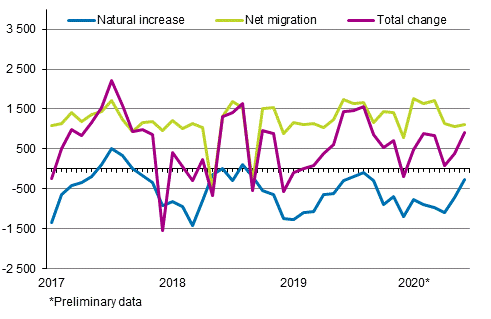Published: 23 July 2020
Only under 5,000 emigrations from Finland in the early part of the year
According to Statistics Finland's preliminary data, Finland's population at the end of June was 5,528,855. During January–June Finland's population increased by 3,563 persons. The reason for the population increase was migration gain from abroad: the number of immigrants was 8,431 higher than that of emigrants. The number of births was 4,729 lower than that of deaths.
Population increase by month 2017–2020*

According to the preliminary statistics for January–June a total of 22,886 children were born, which is 651 more than in the corresponding period 2019. Slightly over one hundred children were born on leap day in 2020. The number of deaths was 27,615 which is 383 higher than one year earlier.
The birth rate rose slightly in the early part of the year from the corresponding period of the year before. In January to June 2020, the total fertility rate was 0.68, while in January to June 2019 it was 0.66. The total fertility rate has been calculated for a period of six months instead of for a calendar year. The figure is approximately half of the number of children a woman on average gives birth to over her lifetime if the fertility rate remains on level with the early part of 2020. The total fertility rate of the whole year cannot be deduced from the figures, because the number of births varies at different times of the year.
In January to June, 13,258 persons moved to Finland from abroad and 4,827 persons moved abroad from Finland. The effects of the restrictions due to the corona virus are visible in these figures on international migration. The number of immigrants was 1,828 lower and the number of emigrants 2,844 lower than in the previous year. The number of emigrants in January to June has last been under 5,000 in the 1990s. In all, 4,103 of the immigrants and 3,087 of the emigrants were Finnish citizens.
According to the preliminary data, the number of inter-municipal migrations totalled 127,978 by the end of June. Compared with the previous year, the increase was 2,477 migrations according to the municipal division of 2020.
Same-sex marriages took legal effect in March 2017. During January–June 2020, same-sex partners entered into 160 marriages of which 102 were between two women and 58 between two men.
According to preliminary data by region, the population grew only in Uusimaa, Pirkanmaa, Southwest Finland, North Ostrobothnia, Åland and Central Ostrobothnia between January–June of 2020.
The population grew most in absolute numbers in Uusimaa, where it grew by 7,298 persons. The next largest increase in population was seen in Pirkanmaa, 1,037 persons. Relative to the population, population growth was highest in Åland, 4.8 per mil, in Uusimaa, 4.3 per mil and in Pirkanmaa, 2,0 per mil. Population loss was highest in absolute numbers in the region of North Karelia that lost 778 persons of its population. The population of North Savo decreased by 685 persons, which was the second biggest population loss. Relative to the population, the biggest population loss was found in South Karelia and North Karelia, in South Karelia 5.1 per mil and North Karelia 4.8 per mil.
Most migration gain from intramunicipal and international migration was collected by Uusimaa, 6,058 persons and Pirkanmaa, 1,262 persons. Most migration gain in relative terms based on total net migration was attained by Åland, 3.8 per mil and Uusimaa, 3.6 per mil.
In absolute numbers, migration loss from total net migration was biggest in the region of Ostrobothnia, 360 persons. In the region of North Karelia the loss was 328 persons. In relative terms, the biggest migration loss from total net migration was found in the region of North Karelia and Ostrobothnia, 2.0 per mil of the population in the both regions.
During January–June 2020, migration between regions numbered 55,688. The positive gain from migration between regions was seen in Uusimaa, Pirkanmaa, Kanta-Häme, Southwest Finland, Päijät-Häme, South Savo, South Ostrobothnia, Åland and Central Ostrobothnia. In absolute numbers, the highest gain from migration between regions was received by Uusimaa, 2,223 persons. Also, the relative migration gain was highest in Uusimaa, 1.3 per mil of the population.
Migration loss from migration between regions was biggest in absolute numbers in the region of Ostrobothnia, 721 persons. Migration loss from migration between regions was biggest in relative terms in the region of Ostrobothnia, 4.0 per mil of the population.
Source: Preliminary population statistics, Statistics Finland
Inquiries: Joonas Toivola 029 551 3355, Juhana Nordberg 029 551 3051, Joni Rantakari 029 551 3249, info@stat.fi
Director in charge: Jari Tarkoma
Publication in pdf-format (252.5 kB)
- Tables
-
Tables in databases
Pick the data you need into tables, view the data as graphs, or download the data for your use.
Appendix tables
- Figures
-
- Appendix figure 1. Live births by quarter 1998 - 2019 and preliminary data 2020 (23.7.2020)
- Appendix figure 2. Deaths by quarter 1998 - 2019 and preliminary data 2020 (23.7.2020)
- Appendix figure 3. Intermunicipal migration by quarter 1998 - 2019 and preliminary data 2020 (23.7.2020)
- Appendix figure 4. Immigration by quarter 1998 - 2019 and preliminary data 2020 (23.7.2020)
- Appendix figure 5. Emigration by quarter 1998 - 2019 and preliminary data 2020 (23.7.2020)
Updated 23.07.2020
Official Statistics of Finland (OSF):
Preliminary population statistics [e-publication].
ISSN=2243-3627. June 2020. Helsinki: Statistics Finland [referred: 17.4.2025].
Access method: http://stat.fi/til/vamuu/2020/06/vamuu_2020_06_2020-07-23_tie_001_en.html

